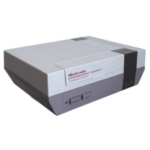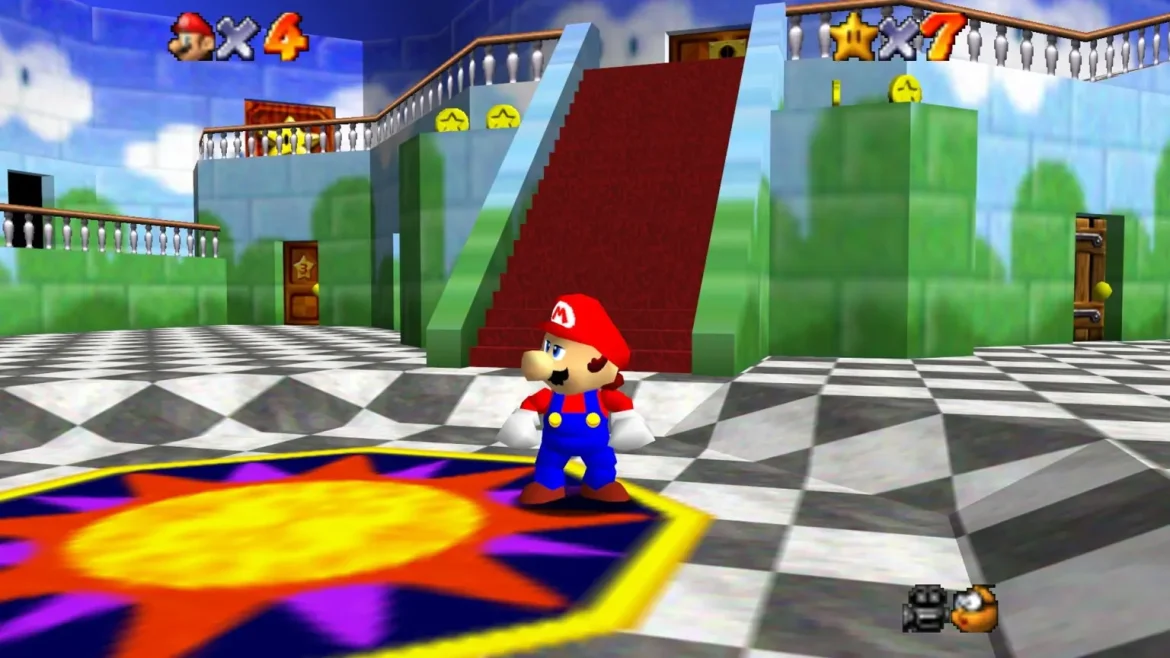
Game Info
Genre: 3D Platformer / Developer: Nintendo EAD / Publisher: Nintendo / Release Date: September 29, 1996 (North America) / Format Reviewed: Nintendo 64 / Other Formats: Nintendo DS (remake), Nintendo Switch (Super Mario 3D All-Stars) / Players: 1
Super Mario 64 Nintendo 64 Review: A 3D Revolution That Still Shines
Picture this: it’s 1996, and you’re gripping the Nintendo 64’s quirky trident-shaped controller for the first time. Super Mario 64 loads up, and Mario leaps into a vibrant 3D world, forever changing how we play video games. This isn’t just a game—it’s a revolution. Released as a launch title for the N64, Super Mario 64 took Mario from 2D side-scrolling to a boundless 3D playground. Developed by Nintendo EAD and published by Nintendo, it set the standard for 3D platformers. In this review, we’ll dive into its gameplay, visuals, legacy, and whether it still holds up in 2025.
Historical Background
Super Mario 64 was born during a pivotal era in gaming. The mid-1990s saw the “console wars” heat up, with Nintendo transitioning from the SNES to the N64 to compete with Sony’s PlayStation and Sega’s Saturn. Nintendo EAD, led by Shigeru Miyamoto, aimed to redefine platforming. Inspired by 2D Mario titles and early 3D experiments like Star Fox, the team crafted a game that leveraged the N64’s 64-bit hardware for open-world exploration.
Development wasn’t without challenges. The jump to 3D required new tools, and the team faced tight deadlines to launch with the N64 in 1996. Fun fact: Mario’s iconic “Yahoo!” and “Wah-ha!” were voiced by Charles Martinet, who recorded lines in a single day, cementing his role as Mario’s voice. Released in Japan on June 23, 1996, and North America on September 29, Super Mario 64 was an instant hit, selling over 11 million copies and shaping the future of gaming.
Gameplay Overview
At its core, Super Mario 64 is about exploration and mastery. The story is classic Mario: Bowser kidnaps Princess Peach, and Mario must collect Power Stars to confront him. Peach’s castle serves as a hub, with paintings leading to 15 courses, each containing seven Stars. The goal? Collect 70 of the 120 Stars to unlock the final battle.
Gameplay blends platforming, puzzle-solving, and exploration. Mario’s moveset—jumps, dives, wall-kicks, and the triple jump—feels intuitive yet deep. Each course, like Bob-omb Battlefield or Whomp’s Fortress, offers unique objectives, from defeating bosses to racing Koopa the Quick. The open-ended design lets players tackle Stars in any order, encouraging creativity. Controls are tight, with the N64’s analog stick offering precision for the era, though modern players might find the learning curve steep.
Visuals and Audio
For 1996, Super Mario 64’s visuals were jaw-dropping. Colorful worlds like Jolly Roger Bay and Cool, Cool Mountain showcased the N64’s power. Mario’s expressive animations and enemy designs ooze charm. However, in 2025, low-resolution textures and polygonal models feel dated compared to modern remakes like Super Mario 3D All-Stars. Still, the art direction holds up, with each course feeling distinct.
The audio is a highlight. Koji Kondo’s soundtrack is unforgettable, from the upbeat Bob-omb Battlefield theme to the eerie Dire, Dire Docks melody. Sound effects, like Mario’s jumps and coin chimes, are iconic. While the N64’s sound chip lacks the clarity of later systems, the music’s emotional range elevates every moment. Fun fact: Kondo composed the soundtrack to loop seamlessly, enhancing immersion during long play sessions.
Strengths and Highlights
Super Mario 64 shines brightest in its innovation and variety. The shift to 3D was seamless, with controls that still feel responsive. Each course is a mini-sandbox, packed with secrets like hidden Stars or 1-UPs. Missions vary wildly—racing, collecting coins, or battling bosses—keeping gameplay fresh. The game’s charm, from Mario’s goofy yells to quirky NPCs like the Pink Bob-ombs, adds personality.
Replay value is sky-high. Collecting all 120 Stars requires skill and patience, with secrets like the Wing Cap or hidden castle areas rewarding exploration. Unlike many linear platformers of the era, Super Mario 64’s open design invites experimentation, making every playthrough unique. Its influence is undeniable, paving the way for games like Banjo-Kazooie and Spyro.
Weaknesses and Critiques
No game is perfect, and Super Mario 64 has flaws. The camera is a notorious pain point. Controlled with the C-buttons, it often clips through walls or refuses to cooperate in tight spaces, leading to frustrating falls. While groundbreaking for its time, the camera feels clunky compared to modern standards.
Some levels, like Tick Tock Clock or Rainbow Ride, suffer from difficulty spikes, with precise platforming that can feel unfair. The story is barebones, even for a Mario game, and the lack of checkpoints in longer missions can frustrate. Visually, while charming, the low-poly models and blurry textures may jolt players used to HD remakes.
Technical Performance
Super Mario 64 pushed the N64 to its limits. Running at a smooth 30 FPS, it rarely stutters, even with large environments. The game’s draw distance was impressive for 1996, though occasional pop-in occurs. Compared to the DS remake, the N64 version lacks extra content but feels more authentic with its original controls.
In 2025, the game holds up well on original hardware or emulators. However, analog stick wear on old N64 controllers can impact precision. The Switch’s 3D All-Stars port offers sharper visuals but alters controls, making the N64 version the purist’s choice.
Cultural Impact and Legacy
Super Mario 64 was a cultural earthquake. Contemporary reviews praised its innovation, with Edge magazine calling it “the greatest game ever made.” It sold over 11 million copies, cementing the N64’s early success. Its legacy endures in every 3D platformer, from Crash Bandicoot to Super Mario Odyssey.
The game birthed speedrunning, with fans mastering glitches like the “Backwards Long Jump” to shave seconds off records. Modding communities keep it alive, creating new levels via tools like SM64 ROM hacks. Its influence extends beyond gaming—Mario’s 3D debut inspired animators and designers across media.
Personal Take and Modern Appeal
Playing Super Mario 64 today feels like revisiting a childhood friend. I still grin when Mario triple-jumps into Bob-omb Battlefield, but curse the camera in Lethal Lava Land. Its magic lies in its simplicity and freedom, offering a pure gaming experience that’s rare in 2025’s bloated titles.
Retro fans and platformer enthusiasts will love it, though newcomers may need patience with the camera and controls. At 8.5/10, it’s not flawless but remains a masterpiece. Dust off your N64 and give it a spin—you won’t regret it.
Conclusion
Super Mario 64 is more than a game; it’s a milestone. Its innovative gameplay, vibrant worlds, and timeless charm outweigh its dated visuals and camera woes. Whether you’re a retro gamer or curious newcomer, it’s a journey worth taking. So, grab that Wing Cap, leap into a painting, and let Mario remind you why gaming is magical.
Coming soon!
Coming soon!
Tips, Tricks, and Cheats
- Tip: Master the Moveset – Practice Mario’s triple jump, wall-kick, and long jump in the castle courtyard to breeze through tough platforming sections.
- Trick: Easy Lives – In Bob-omb Battlefield, repeatedly enter and exit the level to farm 1-UPs from the coin rings near the start.
- Strategy: Star Order – Tackle Stars in any order within a course. If a mission feels too hard, try another to build confidence and skills.
- Cheat: Unlock Caps Early – To get the Wing Cap sooner, collect 10 Stars, then use the cannon in the castle courtyard to reach the floating island.
- Glitch: Infinite Lives – In the castle’s basement, enter Vanish Cap Under the Moat, then repeatedly ground-pound near the waterfall to spawn 1-UPs.


